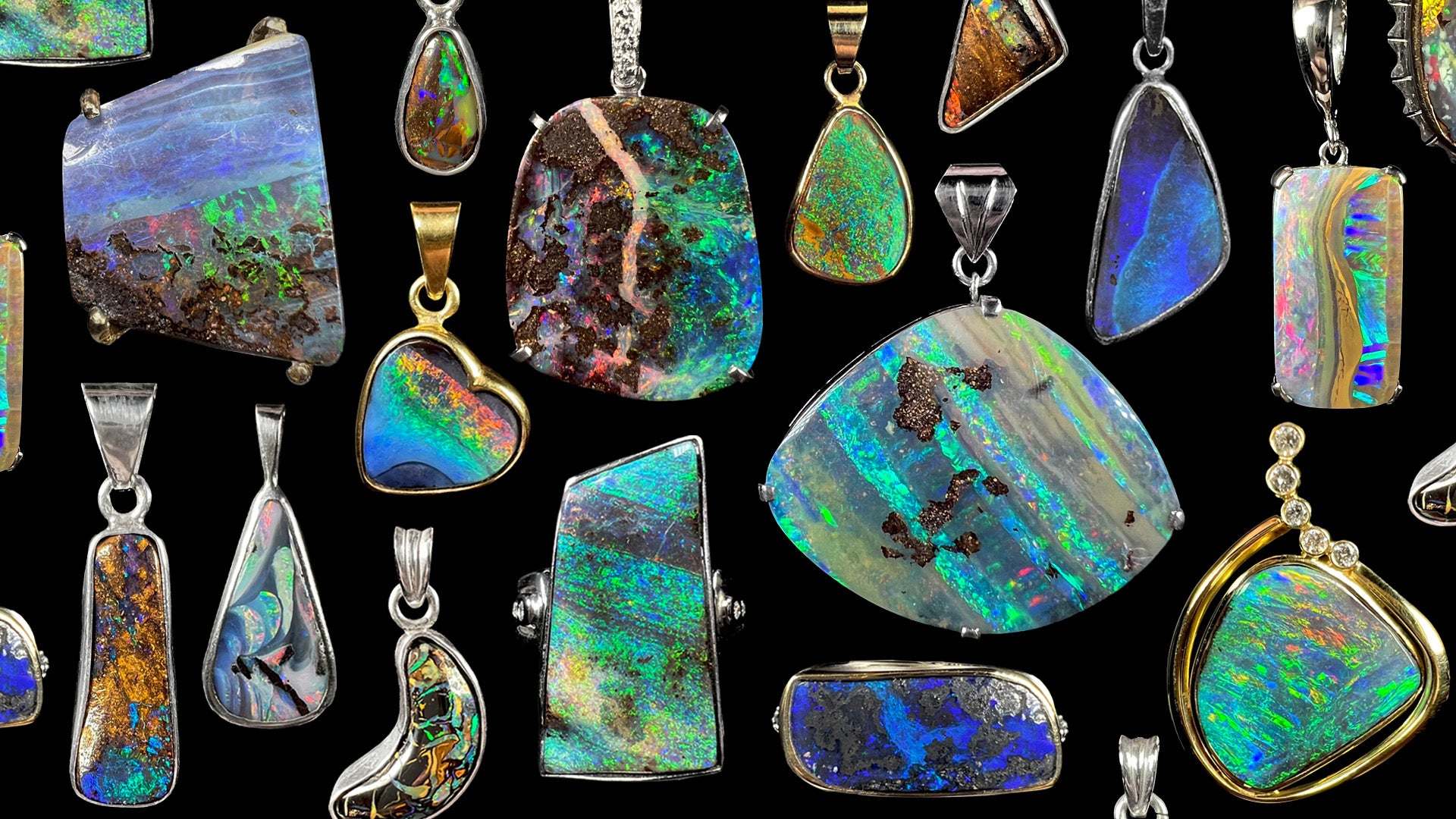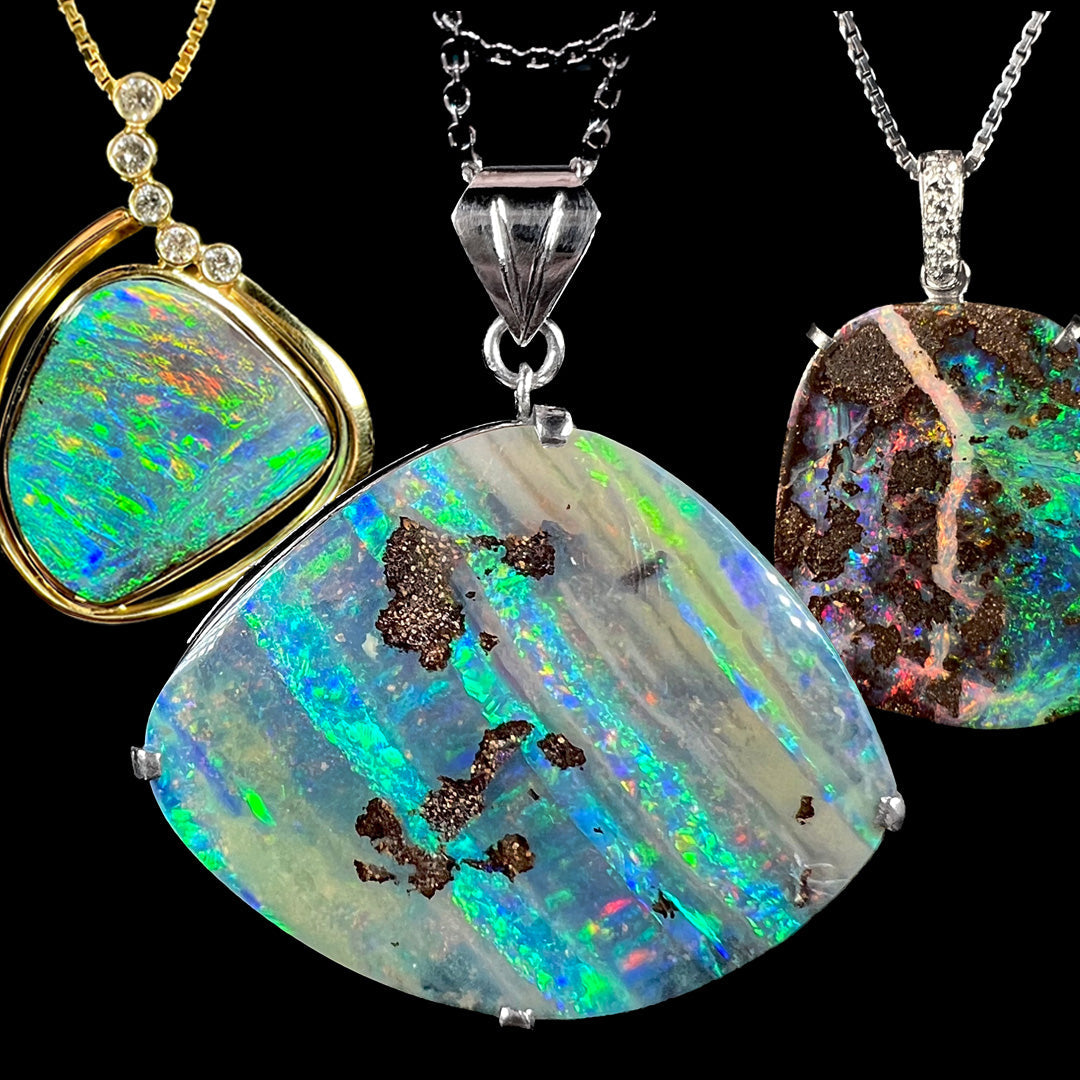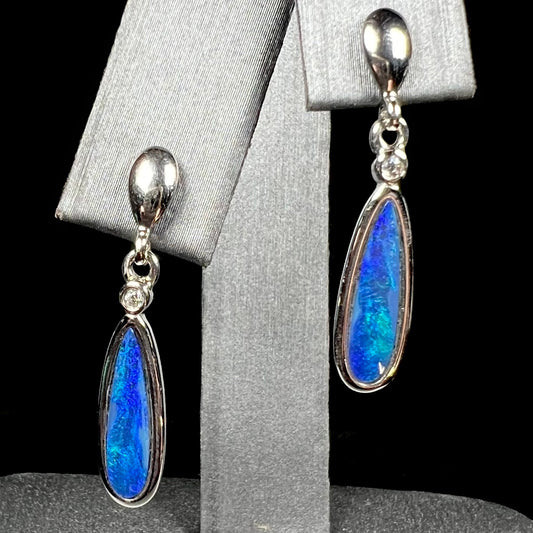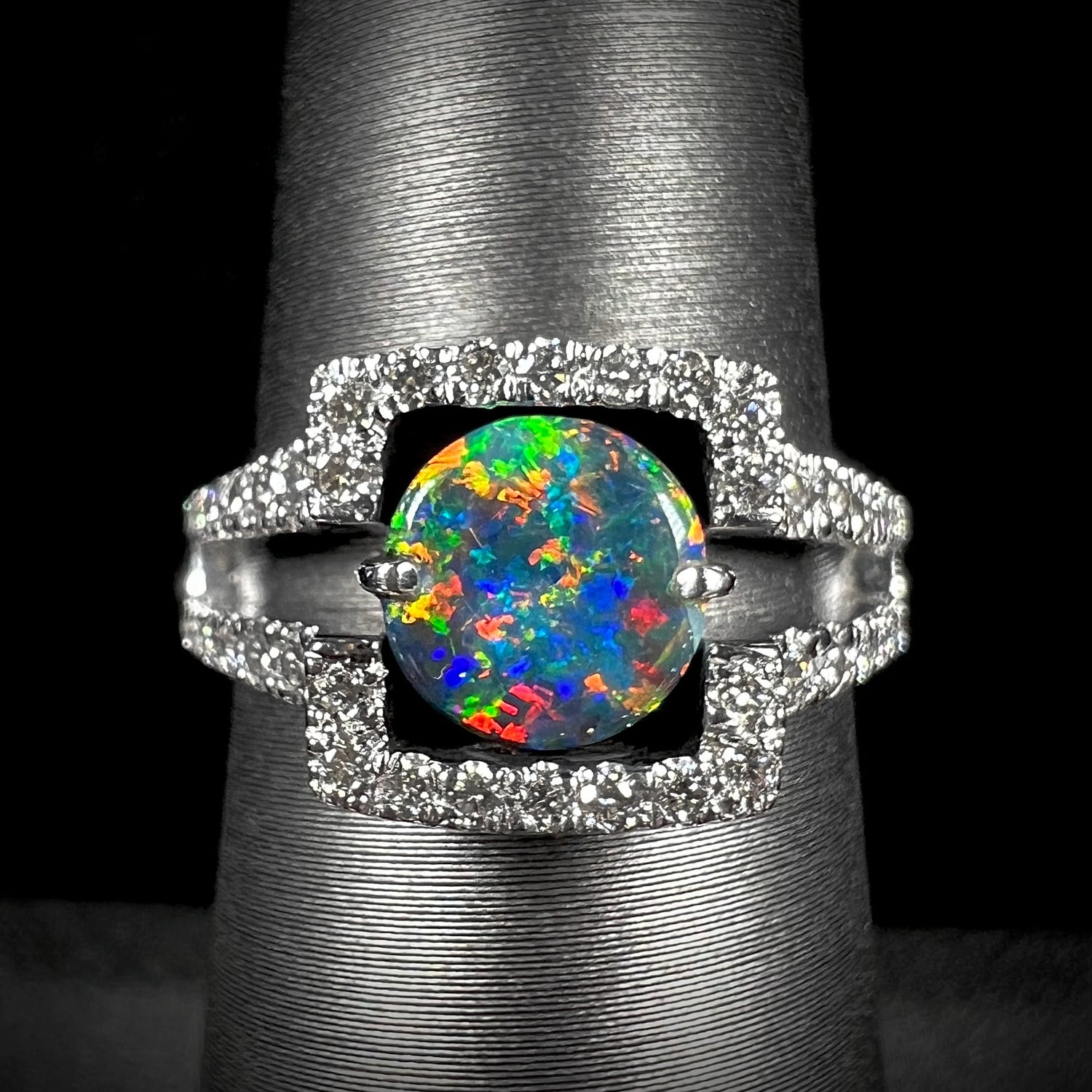Collection: Boulder Opal Jewelry
Boulder opal jewelry is prized for its strength and natural character. Shop our collection below, or click "Learn More" for a full buyer's guide on what to look for when choosing a boulder opal ring or necklace.
-
Jaanvi | 6.00ct Quilpie Boulder Opal Necklace in Sterling Silver
Regular price $360.00 USDRegular priceUnit price / per -
Haisley | 4.50ct Quilpie Boulder Opal Necklace in Sterling Silver
Regular price $425.00 USDRegular priceUnit price / per -
Jedda | "Sam Yah" Boulder Opal Pendant in Sterling Silver
Regular price $385.00 USDRegular priceUnit price / per -
Kalina | Pipe Boulder Opal Pendant in Sterling Silver
Regular price $425.00 USDRegular priceUnit price / per -
Uchin | Estate Artist-Signed Boulder Opal Doublet & Ruby Necklace in Sterling Silver
Regular price $380.00 USDRegular priceUnit price / per -
Lani & Kai | Black Boulder Opal Doublet Dangle Earrings in Sterling Silver
Regular price $360.00 USDRegular priceUnit price / per -
 Sold out
Sold outKai | Sterling Silver
Regular price $370.00 USDRegular priceUnit price / per

Boulder Opal Jewelry: The OpalPop Guide
About Boulder Opal Jewelry
Key Takeaways:
- The Most Durable Opal For Everyday Jewelry: Of all opal varieties, boulder opal is the most durable. Anchored by its natural host rock—most often ironstone—it offers extra strength, making it the safest opal choice for rings, pendants, and other pieces intended for regular wear.
- Opal Jewelry For the Authentic Spirit: Boulder opals often reveal rugged patterns, visible inclusions, and irregular forms that highlight nature’s imperfections. This authenticity makes them appealing to those who value jewelry that feels organic and less refined.
- Opal's Most Complex Expression: The presence of matrix—the rock that the opal forms with—in Australian boulder opal creates intricate patterns where gem and host rock interact. This complexity multiplies opal’s natural diversity, taking the idea of “one-of-a-kind” to an entirely new level.
Jump to Section...
- What is Boulder Opal?
- Who Wears Boulder Opal Jewelry? A Gifting Guide
- 7 Value Factors of Australian Boulder Opal
- Tips For Picking the Perfect Piece of Boulder Opal Jewelry
- Caring For Boulder Opal Jewelry: Cleaning & Durability Tips
- The Many Forms of Boulder Opal
- FAQ
- OpalPop's Boulder Opal Glossary
- Dig Deeper
What is Boulder Opal?
Boulder opal is a variety of opal that remains naturally fused to its parent rock, most often ironstone. This fusion gives the stone extra strength and makes boulder opal the most durable type of opal used in jewelry. Some stones, known as boulder matrix opals (also called picture opals), show delicate veins of color threaded through the host rock, often creating intricate, picture-like designs.
Discovered and first marketed in Queensland, Australia in the late 1800s, the region remains the world’s leading source of boulder opal today. Across Queensland, many different fields contribute to production, each with its own distinctions and overlapping traits. Quilpie and Winton are known for broad sections of precious opal, Koroit for intricate ironstone patterns threaded with color, and Yowah for its geode-like “Yowah nuts.” While these are just a few well-known examples, every field shares the defining bond between opal and host rock that makes boulder opal unique.
How does boulder opal form?
Opal begins as a gel-like mix of water and silica that seeps into cracks, veins, and cavities in host rock. Over thousands—or even millions—of years, the water evaporates, leaving behind hardened deposits of silica that form opal. When the seams of opal are too thin to be cut as standalone stones, they remain attached to the surrounding rock and are cut together, creating what we know as boulder opal.
 (A rough boulder opal from Bull's Creek, Australia, sliced in half showing a rainbow seam of precious opal within an ironstone matrix.)
(A rough boulder opal from Bull's Creek, Australia, sliced in half showing a rainbow seam of precious opal within an ironstone matrix.)
Who Wears Boulder Opal Jewelry? A Gifting Guide
If you’re drawn to a piece of boulder opal jewelry, it’s already for you. But if you’re considering a boulder opal ring or pendant as a gift and aren’t sure if it’s the right fit, the following profiles reflect what we’ve seen again and again in over a decade of helping customers choose their opal jewelry:
- Outdoors Enthusiasts: Boulder opals carry an organic, earthy feel. Many stones contain as much—or even more—ironstone than precious opal, closely resembling the raw material discovered in the Australian outback. Nature lovers often connect with this authentic characteristic.
- Artists and Creatives: Koroit and Yowah boulder matrix opals, in particular, reveal intricate ironstone patterns threaded with flashes of color. Often called “picture opal,” their abstract designs invite pareidolia—the tendency to see familiar images, like faces or shapes, in random patterns—sparking imaginative scenes hidden in the stone, much like a natural work of modern art.
- Free Spirits: Boulder opal jewelry embraces nature’s imperfections. Inclusions are expected, freeform shapes are typical, and mountings are often one-of-a-kind to match each stone. This individuality appeals to those who avoid conventional, cookie-cutter jewelry.
- Practical Wearers: As the most durable opal variety, boulder opals are favored by those who want to “put it on and go.” While care is always important, boulder opal rings and other pieces are the hardiest option for daily wear.
A Note for Gift-Givers
Not every recipient will connect with boulder opal’s nontraditional mystique, but when they do, the result is unforgettable. For a more classic option, consider our white opal jewelry collection, which offers a timeless, traditional appeal.
7 Value Factors of Australian Boulder Opal
Before purchasing boulder opal jewelry, it helps to understand what determines a stone’s value. While some criteria apply to all opals, boulder opals are assessed by a unique combination of traits. The following seven factors work together to establish the price and desirability of each piece.
Factor 1: Size
The first factor to consider in boulder opal is physical size, not carat weight. Carat weight can be misleading because the ironstone matrix is dense, and variations in thickness can make two similar-looking stones weigh very differently. For this reason, dimensions in millimeters or inches give a more accurate sense of value. At OpalPop, we also include scale photos with coins or rulers so buyers can see the true size at a glance.
Factor 2: Percent of Visible Opal in the Face
The “face” of a boulder opal refers to the view from the front of the stone. Value often depends on the proportion of precious opal visible versus the surrounding matrix. A clean-face boulder opal, with no visible matrix on the surface, is generally considered most valuable. However, there are exceptions—unique or artistic matrix patterns can sometimes equal or even exceed the value of the opal itself.
 (This boulder opal pendant shows a near-clean face; minute ironstone inclusions are visible around the edges at 10 o'clock and 5 o'clock positions.)
(This boulder opal pendant shows a near-clean face; minute ironstone inclusions are visible around the edges at 10 o'clock and 5 o'clock positions.)
Factor 3: Brightness of Color Play
Once size and opal coverage are considered, brightness becomes a key factor. Like other opals, boulder opals are graded on a scale of B1 to B5, where B1 shows minimal play-of-color and B5 exhibits vivid flashes visible from a distance. The stronger and more visible the color play, the higher the stone’s value. Exceptional brightness can make even smaller stones highly prized.
Factor 4: Predominant Color Play
The dominant colors in a boulder opal strongly influence its value. Blue and green are the most common and are often the only colors present. Red is the rarest and highly prized, but stones that are predominantly red with additional colors are considered the most exceptional. Even small flashes of red can raise the value of a blue or green stone, and their presence in black boulder opals makes them especially rare and desirable.
Factor 5: Pattern of Matrix
The arrangement of the matrix—the host rock surrounding the opal—can play a major role in pricing. Some stones reveal intricate, abstract designs, while others form recognizable images—a phenomenon known as pareidolia. When a matrix pattern is striking enough to resemble a clear picture, such as an animal or scene, value can rise dramatically. This effect is most often seen in boulder matrix opals.
 (A freeform Koroit boulder matrix opal with veins of precious opal in a patterned ironstone matrix.)
(A freeform Koroit boulder matrix opal with veins of precious opal in a patterned ironstone matrix.)
Factor 6: Body Tone and Color
Body tone refers to the overall background color of the opal, graded on a scale from N1 (black) to N9 (white). In boulder opals, body tone is less influential than in other varieties, except for black boulder opals, which are highly valued. Because the host ironstone can dominate, many boulder opals display brown, gray, or caramel tones outside the standard scale. These stones are usually valued slightly lower but still appreciated for their unique look.
Factor 7: Shape
Shape plays a smaller role in value than size or color but can still contribute. Most boulder opals are cut into freeform shapes that follow the natural contours of the stone to maximize color play. Some shapes are more visually pleasing than others, and when a boulder opal can be cut into a calibrated shape like an oval or pear without losing brilliance, it may command a premium.
Tips For Picking the Perfect Piece of Boulder Opal Jewelry
Choosing opal jewelry is ultimately a personal decision, and what matters most is finding a piece that feels right for you or the person receiving it. While the previous section explained how jewelers assess value, these tips are designed to help you consider what’s most important from a buyer’s perspective.
As with any jewelry, it’s wise to first determine the basics—whether you’re looking for a ring, necklace, or earrings, what your budget allows, and which metal you prefer. Once those decisions are made, the following tips focus on qualities unique to boulder opal jewelry that can guide you toward the perfect match.
Tip 1: Consider the Artistic Gesture of the Piece
Boulder opals are often cut in freeform shapes, giving each piece the feel of wearable art. When choosing a stone, pay attention to the overall gesture, proportions, and symmetry between the opal and its setting. A piece may feel balanced and elegant, or bold and sculptural—what matters most is whether the design feels aesthetically pleasing to you. Rings, necklaces, and earrings can each showcase this artistry in different ways.
Tip 2: Find Patterns in the Matrix that Speak to You
Many boulder opals, especially boulder matrix opals, display intricate natural patterns within the host rock. Some resemble abstract art, while others evoke recognizable images through pareidolia. If you see something that sparks your imagination or feels too striking to ignore, that connection can make the stone especially meaningful. This is part of the unique magic of boulder opal.
 (Ironstone inclusions in this Quilpie boulder opal resemble a melancholy face.)
(Ironstone inclusions in this Quilpie boulder opal resemble a melancholy face.)
Tip 3: How Are Your Favorite Colors Represented?
While reds are the rarest and most valuable colors in the trade, your personal preference should guide your choice. If your favorite color is blue, green, purple, or yellow, choose a stone that highlights those tones most vividly. Boulder opal jewelry is about individuality, and the best piece is the one that resonates with you or your loved one. Value on paper matters less than finding a stone that feels personal.
Tip 4: Inclusions
Boulder opals naturally contain inclusions, since the opal itself forms within the ironstone matrix. Some stones show more than others, and it’s up to each buyer to decide whether those inclusions add charm or distraction. What one person may see as a flaw, another might see as a defining feature of character. Unlike diamonds, where clarity is critical, inclusions in boulder opals are part of their story.
Tip 5: Directionality of Color Play
Directionality describes how color play appears when the stone is viewed from different angles. Some boulder opals are non-directional, flashing brightly no matter how they’re turned, while others show their best colors only from a specific angle. The key is whether the effect feels pleasing and practical for you. Consider how the stone is mounted in jewelry and whether you’ll actually see its colors during wear.
Caring For Boulder Opal Jewelry: Cleaning & Durability Tips
How Durable Is Boulder Opal Jewelry?
Boulder opal is widely regarded as the most durable variety of opal, thanks to the stabilizing presence of its ironstone matrix. That said, the opal itself is still opal—so while it’s stronger than crystal or white opal, it’s not indestructible. Sharp blows, especially to opals with large surface areas, can still cause damage.
A good rule of thumb is to treat opal jewelry with the same care you would give glass. That doesn’t mean it’s fragile—many boulder opals are strong enough for everyday wear—but removing your ring before working with your hands is always a wise move. Earrings and pendants are generally lower risk, but mindfulness is still key.
One of boulder opal’s standout qualities is its long-term stability. These stones aren’t prone to cracking or crazing, and they won’t change color with age. Boulder opal jewelry is also perfectly safe to get wet, so there’s no need to panic if you forget to take it off before a shower or swim.
How to Clean Boulder Opal Jewelry
The simplest and safest way to clean your boulder opal jewelry is with warm water, mild dish or hand soap, and a soft-bristled toothbrush. Gently scrub behind the setting and around the stone, then rinse thoroughly and pat dry with a soft cloth.
While boulder opal is generally safe in ultrasonic cleaners, it's best to use caution. If your stone shows natural fissures or internal cracks, stick with gentle manual cleaning instead. Ultrasonics can sometimes worsen existing features, so hand-cleaning is the safest universal approach.
 (A soft-bristled toothbrush, soapy water, and a soft cloth or paper towel is everything you need to properly clean your boulder opal jewelry.)
(A soft-bristled toothbrush, soapy water, and a soft cloth or paper towel is everything you need to properly clean your boulder opal jewelry.)
A Little Care Goes a Long Way
Boulder opal jewelry can absolutely be worn and enjoyed often—but like any fine jewelry, a little caution will help preserve its beauty for the long haul. With a little care, your boulder opal jewelry can be enjoyed for generations while retaining its natural beauty.
The Many Forms of Boulder Opal
Boulder opal doesn’t follow a single formula. While most commercial boulder opal jewelry features precious opal formed in ironstone matrix, nature has a few more surprises in store. From opal hidden in fossilized wood to geode-like concretions that crack open to reveal a hidden fire, the diversity within boulder opal is wider than most realize.
Below are some of the more unusual or lesser-known forms that exist across the Australian opal fields—and beyond.
Boulder Matrix Opal (a.k.a Picture Opal)
Boulder matrix opal—sometimes called picture opal—is a distinct variety where veins of precious opal weave through intricately patterned ironstone. It’s most commonly sourced from Queensland’s Koroit and Yowah fields. These stones often surprise first-time viewers with their complexity, evoking pareidolia—the human tendency to see faces or imagery in abstract patterns. In these pieces, the ironstone isn’t just a backdrop; it’s part of the artwork.
 (A Koroit boulder matrix opal with veins of precious opal that form a flame-like pattern.)
(A Koroit boulder matrix opal with veins of precious opal that form a flame-like pattern.)
Boulder Opal Splits
When a seam of opal is encased in ironstone, cutters will sometimes cleave the stone along the seam to reveal two mirrored halves. These “splits” can make ideal earring pairs or matched jewelry sets and offer a unique window into how opal forms underground—like slicing through a mineral time capsule.
Yowah Nut Opal
Found near the small Queensland town of Yowah, these rounded ironstone concretions resemble geodes. When cut open, they may reveal nothing—or, on rare occasions, a brilliant surprise of precious opal hiding inside. Each half of a Yowah nut is naturally unique, and their intricate patterns make them popular with collectors and lapidaries alike.
 (The inside of a Yowah nut boulder opal, cut into two halves, each containing precious opal in the center.)
(The inside of a Yowah nut boulder opal, cut into two halves, each containing precious opal in the center.)
Sandstone-Hosted Boulder Opals
While most boulder opals form in ironstone, some develop in sandstone. Two well-known types are:
• Pipe Opal – Named for its round, tubular formations, pipe opal forms inside ancient cavities in sandstone.
• Painted Lady Opal – A colorful variety from Andamooka, this type often features delicate pastel hues within a soft sandstone matrix. Painted ladies are known to be fragile and may crack during cutting as the sandstone “settles” into stability.
 (Left: Painted lady boulder opal specimen; Right: Collection of pipe opal pendants.)
(Left: Painted lady boulder opal specimen; Right: Collection of pipe opal pendants.)
Opalized Wood (Fossil Opal)
Sometimes opal doesn’t just fill cracks—it replaces an object entirely. In rare cases, boulder opal forms inside petrified wood, preserving the structure of ancient trees with flashes of fire. These fossil opals have been found in Australia (such as Duck Creek in Queensland), as well as Mexico, Oregon, and Nevada’s Virgin Valley. While often referred to as “opalized wood,” it’s important to remember these are fully fossilized stones—not actual wood.
 (A polished opalized wood specimen with green and blue color play.)
(A polished opalized wood specimen with green and blue color play.)
Cantera Opal (Mexican Matrix Opal)
Though not classified as boulder opal in the strict trade sense, Cantera opals from Mexico form inside volcanic matrix and resemble egg-like cabochons of vibrant orange or red fire opal. Some sellers market them as “Mexican boulder opals,” and while technically they are matrix opals, the term is arguably fitting. Like Australian boulder opals, they are solid stones where the opal is naturally embedded in its host rock.
 (A trio of Mexican Cantera opals.)
(A trio of Mexican Cantera opals.)
Boulder Doublets (Manmade Composites)
True boulder opals are always solid, but imitations—known as boulder doublets (often referred to as "boulder opal doublets")—exist. A boulder doublet is a layered stone: a thin slice of natural opal is bonded to an ironstone backing with epoxy, creating the appearance of a thicker opal face. These can often be spotted by a visible seam around the edge of the stone—though dyed epoxy can make them harder to detect. While technically composed of real materials, doublets are not considered solid opal and are valued significantly lower than their natural counterparts.
 (Side view of a convincing boulder doublet set in a half-bezel ring. The top layer is natural opal; its backside was painted black to resemble black opal when viewed from the face. The lighter-colored center layer is epoxy, dyed to resemble the darker ironstone layer below. A bubble-like crater can be seen in the center of the epoxy.)
(Side view of a convincing boulder doublet set in a half-bezel ring. The top layer is natural opal; its backside was painted black to resemble black opal when viewed from the face. The lighter-colored center layer is epoxy, dyed to resemble the darker ironstone layer below. A bubble-like crater can be seen in the center of the epoxy.)
The Beauty of Variety
From clean-faced pendants to wildly patterned rings, boulder opal jewelry showcases a remarkable range of forms. We hope this guide helps you understand the story behind the stone—and find the perfect piece for your collection.
Acknowledgements
We thank Burton's Gems and Opals for allowing us to photograph and share their extensive loose opal collection, as seen in this article.
FAQ
Can I wear my boulder opal jewelry every day?
Yes. Boulder opal is the most durable type of opal, supported by its ironstone host rock. Still, care should be taken with boulder opal rings that show larger areas of precious opal. We recommend removing them when doing heavy work with your hands.
Where does boulder opal come from?
In the jewelry trade, “boulder opal” almost always refers to Australian boulder opal, primarily mined in Queensland. Technically, though, boulder opal can occur anywhere opal forms within a host rock, since the definition is based on structure rather than location.
Is boulder opal completely natural?
Yes. Boulder opal is a completely natural gemstone, formed as opal and host rock together in one stone. The main exceptions are imitations such as boulder doublets, which are assembled from thin opal slices bonded to ironstone.
Can I get my boulder opal jewelry wet?
Yes, boulder opal jewelry is generally safe to get wet and even to bathe in. Its ironstone host provides stability, though care is always recommended for long-term preservation.
What is boulder matrix opal?
Boulder matrix opal is a precious opal that forms as fine veins or patches within the host rock itself. This creates intricate patterns often nicknamed “picture opal,” as many stones reveal images or abstract designs within the matrix.
What is a boulder opal doublet?
A boulder opal doublet—or simply "boulder doublet"—is an imitation of natural boulder opal. It’s made by bonding a thin slice of precious opal to a backing of polished ironstone, usually with epoxy. Sometimes the adhesive is darkened or dyed to create a more convincing, uniform appearance.
OpalPop’s Boulder Opal Glossary
This glossary explains common terms you’ll encounter when exploring boulder opal jewelry, from mining locales like Koroit and Quilpie to cutting styles such as freeform and split.
Boulder Doublet:
A boulder doublet is an imitation boulder opal made by bonding a thin slice of natural opal to an ironstone backing with epoxy. This creates the appearance of natural boulder opal but is a man-made composite.
Boulder Matrix Opal:
Boulder matrix opal is a natural combination of opal and host rock, where veins or patches of opal run through the stone itself. These intricate patterns are especially common in material from Koroit, Australia.
Boulder Opal:
Boulder opal is a variety of opal cut with part of its natural host rock still attached. Most often the matrix is ironstone, but it can also include sandstone or petrified wood.
Clean-Face:
A clean-face boulder opal shows no visible matrix inclusions on the front of the stone. Its surface is entirely opal, either precious opal with color play or potch opal without it.
Face:
The “face” of an opal refers to the front, visible surface of the stone when viewed in jewelry. Value is often influenced by how much precious opal appears on the face compared to matrix or inclusions.
Freeform:
A freeform cut refers to an irregularly shaped gemstone cut to follow the natural contours of the stone. Boulder opals are frequently freeform, since the opal often forms in unpredictable seams and pockets.
Koroit:
Koroit is a mining field in South West Queensland, Australia, famous for producing intricately patterned boulder matrix opals. These stones are often called “picture opals” for their abstract, art-like designs.
Matrix:
Matrix is the host or “parent” rock that opal forms within. In boulder opal, this is usually ironstone, though sandstone, fossils, shells, and even potch opal can serve as matrix material.
Opalized Wood:
Opalized wood is a form of opal that developed with petrified wood. The organic material was replaced by silica over time, creating a fossil-like stone also called “wood opal.”
Painted Lady:
Painted lady opals are a variety of matrix opal from Andamooka, Australia, formed in soft sandstone. These opals often display pastel colors and may develop surface cracks during cutting as the host rock naturally stabilizes.
Pareidolia:
Pareidolia is a psychological phenomenon where the mind perceives familiar images, often faces, in random patterns. Many people experience pareidolia when viewing the intricate designs in boulder matrix opal.
Pipe Opal:
Pipe opal is a form of boulder opal that develops in tube-like cavities, often within a sandstone matrix.
Potch:
Potch opal, also known as common opal, is opal that shows no play of color. In boulder opal it usually appears brown or tan, though potch can also occur in shades like blue, pink, or green.
Quilpie:
Quilpie is a mining region in South West Queensland, Australia, known for producing boulder opals with large, solid patches of opal across the face, rather than the finer patterns seen in matrix opals.
Split:
A split boulder opal forms when a seam of opal naturally cleaves along its host rock. This process often creates two matching halves, which are commonly paired in boulder opal earrings.
Yowah:
Yowah is a mining area in South West Queensland, Australia, best known for producing Yowah nut opals—small, ironstone nodules with geode-like centers of opal.
Yowah Nut:
A Yowah nut is a geode-like boulder opal from Yowah, Australia. These ironstone nodules are cut open to reveal their centers, which may contain little or no opal, patterned matrix, or—rarely—solid precious opal.
Dig Deeper
Explore more curated collections similar to boulder opal jewelry:
-

Boulder Opal Necklaces
The perfect fusion of Mother Nature and fine art, boulder opal necklaces...
-

Boulder Opal Rings
Looking for more options? Explore these curated opal ring collections: All Opal...
-

Quilpie Boulder Opal Jewelry
Looking for more options? Explore these curated opal jewelry collections: All Opal...
-

Australian Opal Jewelry
Looking for more options? Explore these curated opal jewelry collections: All Opal...
-

Freeform Opal Jewelry
Looking for more options? Explore these curated opal jewelry collections: All Opal...












